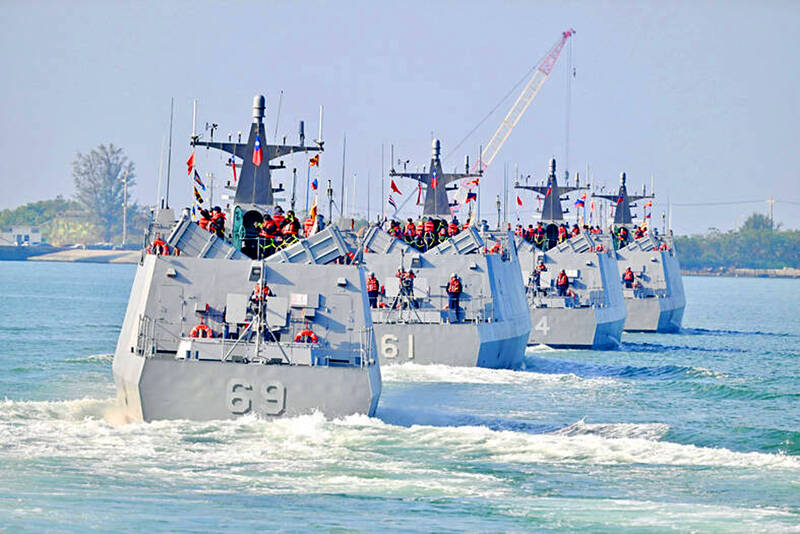Taiwan must take steps to avoid being blamed for escalation if it responds with force to Chinese naval incursions into its territorial waters, a former US Navy intelligence head said.
The best way to handle violent tactical encounters is to shape the information space early — exposing Chinese actions and framing them as aggressors, provocateurs and a threat not just to Taiwan, but to the entire region, former US Office of Naval Intelligence commander Mike Studeman said on Friday.
Studeman — who reportedly visited Taiwan in 2020 while serving as director of the J2 intelligence division at the US Indo-Pacific Command, making him one of the highest-ranking US military officers to visit Taiwan over the past few years — was asked by the Central News Agency about a tabletop war game held in Taipei last week that simulated a 2030 scenario in which Chinese navy ships intrude into Taiwan’s territorial waters amid escalating tensions.

Photo: Tu Chien-jung, Taipei Times
In the war game, Taiwan chose not to immediately strike Chinese navy vessels that entered its territorial waters.
Instead, it deployed coast guard and navy ships to shadow the intruders, and positioned submarines in ambush zones northeast and southwest of Taiwan proper, and said this approach was guided by its principle of not firing the first shot.
“The moral high ground and legitimacy of any tactical actions will be contested in the information domain,” said Studeman, who is a national security fellow at MITRE, a nonprofit research group.
At the Taipei war game on Tuesday and Wednesday last week, attended by former US and Japanese defense officials, the US officials said Taiwan might eventually need to open fire to expel Chinese intruders — but emphasized the importance of giving advance warning.
China has a broader propaganda reach, ready to portray itself as the victim of any Taiwan-initiated aggression, Studeman said.
“Worst case, Taiwan’s actions could justify harsh countermeasures from Beijing across all domains to punish Taiwan,” he said.
“I don’t think we can easily predict what level of support political leaders [in Washington and Tokyo] might be willing to provide to Taipei, especially if the tactical interaction becomes a ‘he said, she said’” situation, Studeman added.
“Taiwan must repeatedly warn that China is pressing up to red lines that will require a strong Taiwan response,” he said.
“Failure to demonstrate the appropriate use of strength and resolve at the right time in the right way will only invite deeper and unacceptable encroachments,” Studeman said.
Such developments could “ultimately compromise the defense system required to protect Taiwan’s existence as a democracy,” he added.

SHIPS, TRAINS AND AUTOMOBILES: The ministry has announced changes to varied transportation industries taking effect soon, with a number of effects for passengers Beginning next month, the post office is canceling signature upon delivery and written inquiry services for international registered small packets in accordance with the new policy of the Universal Postal Union, the Ministry of Transportation and Communications said yesterday. The new policy does not apply to packets that are to be delivered to China, the ministry said. Senders of international registered small packets would receive a NT$10 rebate on postage if the packets are sent from Jan. 1 to March 31, it added. The ministry said that three other policies are also scheduled to take effect next month. International cruise ship operators

NUMBERS IMBALANCE: More than 4 million Taiwanese have visited China this year, while only about half a million Chinese have visited here Beijing has yet to respond to Taiwan’s requests for negotiation over matters related to the recovery of cross-strait tourism, the Tourism Administration said yesterday. Taiwan’s tourism authority issued the statement after Chinese-language daily the China Times reported yesterday that the government’s policy of banning group tours to China does not stop Taiwanese from visiting the country. As of October, more than 4.2 million had traveled to China this year, exceeding last year. Beijing estimated the number of Taiwanese tourists in China could reach 4.5 million this year. By contrast, only 500,000 Chinese tourists are expected in Taiwan, the report said. The report

HORROR STORIES: One victim recounted not realizing they had been stabbed and seeing people bleeding, while another recalled breaking down in tears after fleeing A man on Friday died after he tried to fight the knife-wielding suspect who went on a stabbing spree near two of Taipei’s busiest metro stations, Taipei Mayor Chiang Wan-an (蔣萬安) said. The 57-year-old man, identified by his family name, Yu (余), encountered the suspect at Exit M7 of Taipei Main Station and immediately tried to stop him, but was fatally wounded and later died, Chiang said, calling the incident “heartbreaking.” Yu’s family would receive at least NT$5 million (US$158,584) in compensation through the Taipei Rapid Transit Corp’s (TRTC) insurance coverage, he said after convening an emergency security response meeting yesterday morning. National

The Forestry and Nature Conservation Agency yesterday launched a gift box to market honey “certified by a Formosan black bear” in appreciation of a beekeeper’s amicable interaction with a honey-thieving bear. Beekeeper Chih Ming-chen (池明鎮) in January inspected his bee farm in Hualien County’s Jhuosi Township (卓溪) and found that more than 20 beehives had been destroyed and many hives were eaten, with bear droppings and paw prints near the destroyed hives, the agency said. Chih returned to the farm to move the remaining beehives away that evening when he encountered a Formosan black bear only 20m away, the agency said. The bear